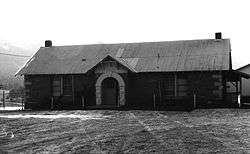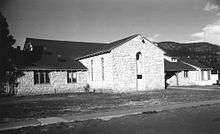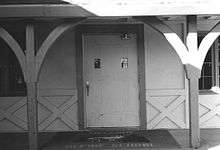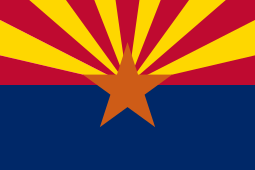Alpine Elementary School (Alpine, Arizona)
The Alpine Elementary School is a compound consisting of four buildings in Alpine, Arizona. The original school building was built in 1930, while the current gym/auditorium was constructed as an LDS chapel in 1939. There are also two more recent constructions consisting of modular buildings, which are not considered as contributing to the historical nature of the site.
Alpine Elementary School | |
 School building | |
  | |
| Location | 11 and 12 Co. Rd. 2052, near jct. with US 180, Alpine, Arizona |
|---|---|
| Coordinates | 33°49′38″N 109°08′37″W |
| Area | 2.5 acres (1.0 ha) |
| Built | 1930 |
| Architect | School - Unknown Chapel - Alexander & Burton |
| Architectural style | concrete foundation, limestone walls |
| NRHP reference No. | 97000369[1] |
| Added to NRHP | April 25, 1997[2] |
History
The schoolhouse was constructed as a two-room schoolhouse in 1930. It had been preceded by four earlier schoolhouses. The first schoolhouse was a 20 foot by 20 foot log construction built in 1882. This structure was expanded to 40 by 20 in 1885. This remained the town's only schoolhouse until the mid-1910s, when it was accidentally burned down by two students. A second structure, this one of wood frame, was constructed at a cost of $4,000 in 1916–17, and opened in the fall of 1917. The structure contained two classrooms, a stage, and a recreation hall. With a capacity of 300 people, it could hold more than the total population of the town. Lightning struck the building in 1919, resulting in a fire which burned the school to the ground. A temporary structure, again of rough-hewn timber was constructed to handle classes beginning in 1920. In addition to holding classes, all three of these buildings were also used for town meetings as well as religious services.[3]
In 1930 the town spent $4,800 to construct the current stone schoolhouse, which opened for classes in the fall. The building consisted of two classrooms and two cloakrooms. Two outhouses were in the building's rear. The structure was of concrete foundation and red limestone walls; the limestone came from a quarry approximately three miles south of the town. One of the classrooms held class for grades 1 through 4, while the other conducted classes for grades 5 through 8. During the 1930s the enrollment varied between the high 20s and low 40s. Upon finishing eighth grade, any students wishing to attend high school were bussed to Round Valley High School, about 20 miles to the north in Eagar.[3]
During the 1930s the schoolhouse was also the township's meeting hall, as well as hosting many different functions, activities and both public and private events. It also served as the community's LDS church.[3] During the 1940s the outhouses were replaced by interior restrooms and indoor plumbing.
The growth of the community saw the need for a chapel for the LDS ward. Alexander & Burton designed the building, and construction on the chapel began in 1938, handled by the construction firm of C. Bryant Whiting of nearby Springerville. The same red limestone as the schoolhouse was used for the chapel. Crude blocks were quarried, than transported to the site by horse-drawn wagons, where they were finished by local workmen, who were supervised by an Italian stonemason. Wood for the interior was supplied from Forest Service lands, a total of 150,000 board-feet was processed at a local sawmill owned by a Bishop of the LDS church. The milled arches at the front entry, along with other decorative elements were created using a wheeled bandsaw. Whiting completed the construction on time in the Spring of 1939, and came in under budget, costing less than $17,000. The first use of the structure was by the Relief Society, which held a meeting on April 30, 1939. With its larger meeting room, it replaced the schoolhouse as the community's meeting hall, as well as religious center.[3]
According to some accounts, the two-room schoolhouse is the oldest school building in Apache County to see continuous use. In December 1972, due to declining membership, the LDS ward was dissolved. In 1987 the Alpine Elementary School District acquired the former chapel, and combined it with the schoolhouse, to be used as a multipurpose room and gymnasium. In addition to its scholastic activities, the chapel continues to be used for community events and meetings.[3]
Structure
The complex consists of several buildings: two older stone structures, the schoolhouse built in 1930 and the former chapel (now used as a gym/multipurpose room) built in 1938–39; and two more modern pre-fabricated modular buildings which were erected in the mid to late 1970s.
School building

The school is a one-story building with a concrete foundation and red limestone walls of ashlar construction. The corners of the building contain quoins of white limestone, and the roof is galvanized sheet metal. There are two entries to the building, on the east and west sides of the building. The main entry lies to the east, with the rear entry to the west. Both entries have double wooden doors inside of which is a vestibule adorned with stone piers with concrete arches. The schoolhouse architecture is of no particular singular style. American Craftsman and Bungalow style can be seen in the decorative wooden shingles below the gable ends, three-light panel doors, and knee braces; Romanesque Revival style is seen in the rounded arches of the two entries.
Originally, the interior consisted of two classrooms and a coatroom. In the 1940s the external outhouses were replaced with the installation of internal plumbing and two restrooms. The classrooms are divided by a sliding wooden partition. The original wood-burning stoves used to heat the structure have since been replaced by central heating. Neither the architect or builder is known.[3]
Former chapel

The gymnasium is a one and half story building with an asymmetrical floorplan and cross-gabling. Like the schoolhouse, it has a concrete foundation, although it has a partial basement. Like the school, it has dressed limestone walls set in a random ashlar pattern, but differs from the school in that the limestone is white, rather than red. Its roof is made of composition shingles. The front of the building has a recessed porch supported by wooden arches; its front door has solid batten construction with wrought-iron hinges. Decorative Stick style flourishes can be found at the front entry, and both the east and west gable ends. Other decorative touches include notched rafter ends on each eve, as well as the dormer roof. Most of the building's windows are of the metal casement style with wooden sashes, original to the structure, except for one which has been replaced by a modern aluminum slider.[3]

The original assembly room of the chapel became the school's auditorium and gymnasium, the original flooring replaced by maple hardwood, to serve as the surface for a basketball court. The former church office was redone to become a kindergarten room, and two smaller rooms were combined to become the home economics classroom, which also doubles as the school's cafeteria. An interior restroom has also been added.[3]
Alexander & Burton were the architects of the chapel. They designed several LDS churches during the 1930s and 1940s, including the Phoenix LDS Third Ward Chapel and the LDS church in St. Johns, both built in 1938. The chapel was built by C. Bryant Whiting, a Springerville contractor, and its successful completion led to his success as a contractor.[3]
Other buildings
Originally, there were two outhouses to the rear of the school building, but they were removed when interior plumbing and restrooms were installed in the 1940s. Between 1976–79 two prefabricated modular buildings were constructed behind the schoolhouse, in order to increase the capacity of the school. One of the modules houses the school's offices and a music room, while the other contains the library and a learning library.[3]
See also

- National Register of Historic Places listings in Apache County, Arizona
References
- "National Register Information System". National Register of Historic Places. National Park Service. July 9, 2010.
- "Alpine Elementary School". National Park Service. Retrieved January 15, 2017.
- "National Register of Historic Places Continuation Sheet". National Park Service. Retrieved January 15, 2017.